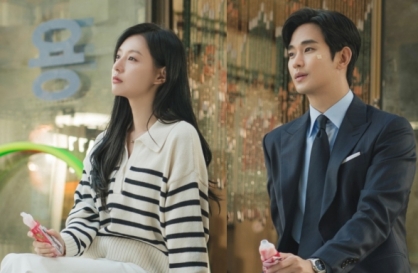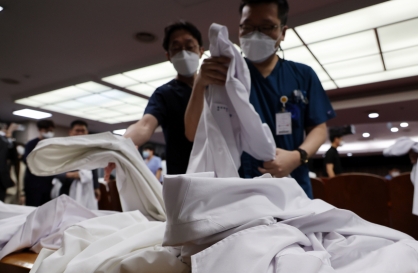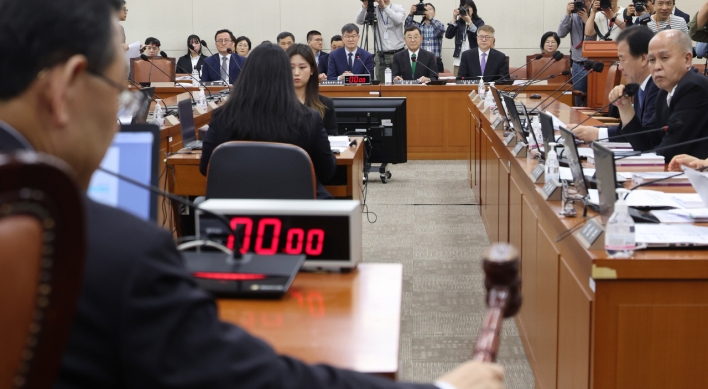David Ogilvy, often cited as the 20th century’s most inspiring advertising guru, once said, “Advertising is only evil when it advertises evil things.”
Ogilvy apparently was not thinking of other vices, such as constant, in-your-face advertisements that can be just as damaging as unethical ads.
A week ago, on an episode of top-rated KBS weekend soap opera “My Daughter Seo-young,” Samsung’s Galaxy phones were exposed up to 10 times during the 50-minute program.
Sang-woo, one of the main protagonists, would check his phone multiple times to make sure the unmistakable Galaxy display was fully exposed. He would then agonize over text messages from his now ex-girlfriend Mi-kyung, who would do the same over her Galaxy as the star-crossed lovers struggled to accept their cruel fate.
The situation is the same for the rest of the cast, including Seo-young, Sang-woo’s sister, who is endlessly calling her husband and checking his messages. Only Seo-young’s dad, due to poverty, is let off the hook and uses a clunky feature phone.
The phones, no matter how good or smart they look, even get in the way of the tears and drama as some scenes appear to be intentionally built around the handsets to please the advertisers.
Hollys Coffee, a well-known coffee chain, also is quite blatantly exposed: All caffeine-guzzling members of the cast seem to drink only coffee from this particular brand. But compared to the Galaxy, the rate of appearance is quite low, probably because they paid less. And it’s not jut “My Daughter”: the majority of soap operas and dramas are riddled with these fleeting ads.
Advertising, including product placement through television, is most certainly legitimate ― a law revision was passed in July 2009 permitting all logos and brands to be revealed for paying advertisers ― but sometimes it can be a bit too much.
When the exposure feels forced and unnecessary, viewers will naturally wonder: Exactly how effective will it be in portraying a positive image about the product?
By Kim Ji-hyun (jemmie@heraldcorp.com)
Ogilvy apparently was not thinking of other vices, such as constant, in-your-face advertisements that can be just as damaging as unethical ads.
A week ago, on an episode of top-rated KBS weekend soap opera “My Daughter Seo-young,” Samsung’s Galaxy phones were exposed up to 10 times during the 50-minute program.
Sang-woo, one of the main protagonists, would check his phone multiple times to make sure the unmistakable Galaxy display was fully exposed. He would then agonize over text messages from his now ex-girlfriend Mi-kyung, who would do the same over her Galaxy as the star-crossed lovers struggled to accept their cruel fate.
The situation is the same for the rest of the cast, including Seo-young, Sang-woo’s sister, who is endlessly calling her husband and checking his messages. Only Seo-young’s dad, due to poverty, is let off the hook and uses a clunky feature phone.
The phones, no matter how good or smart they look, even get in the way of the tears and drama as some scenes appear to be intentionally built around the handsets to please the advertisers.
Hollys Coffee, a well-known coffee chain, also is quite blatantly exposed: All caffeine-guzzling members of the cast seem to drink only coffee from this particular brand. But compared to the Galaxy, the rate of appearance is quite low, probably because they paid less. And it’s not jut “My Daughter”: the majority of soap operas and dramas are riddled with these fleeting ads.
Advertising, including product placement through television, is most certainly legitimate ― a law revision was passed in July 2009 permitting all logos and brands to be revealed for paying advertisers ― but sometimes it can be a bit too much.
When the exposure feels forced and unnecessary, viewers will naturally wonder: Exactly how effective will it be in portraying a positive image about the product?
By Kim Ji-hyun (jemmie@heraldcorp.com)
-
Articles by Korea Herald




![[Grace Kao] Hybe vs. Ador: Inspiration, imitation and plagiarism](http://res.heraldm.com/phpwas/restmb_idxmake.php?idx=644&simg=/content/image/2024/04/28/20240428050220_0.jpg&u=)

![[Herald Interview] Mom’s Touch seeks to replicate success in Japan](http://res.heraldm.com/phpwas/restmb_idxmake.php?idx=644&simg=/content/image/2024/04/29/20240429050568_0.jpg&u=)


![[News Focus] Lee tells Yoon that he has governed without political dialogue](http://res.heraldm.com/phpwas/restmb_idxmake.php?idx=644&simg=/content/image/2024/04/29/20240429050696_0.jpg&u=20240429210658)









![[Today’s K-pop] Seventeen sets sales record with best-of album](http://res.heraldm.com/phpwas/restmb_idxmake.php?idx=642&simg=/content/image/2024/04/30/20240430050818_0.jpg&u=)